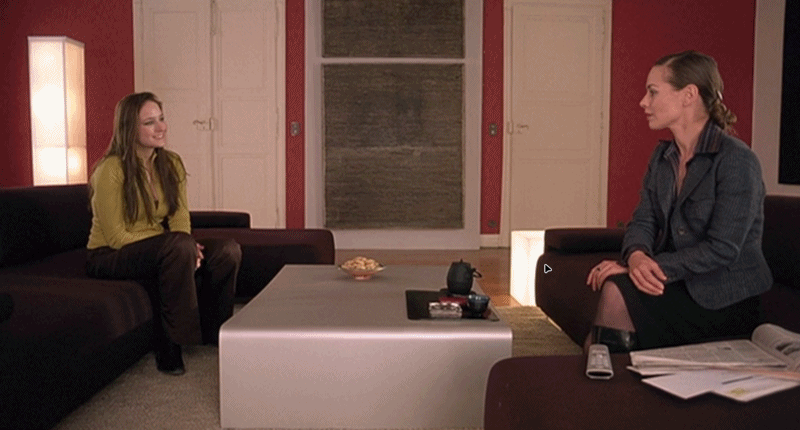In a Dark Place (2006) – Film Review

Filmed in Luxembourg, In a Dark Place takes Henry James’ classic horror story “The Turn of the Screw” and places it in a modern setting. The story has been dramatized several times over the years, and most versions retain the Victorian setting of James’ novella, so In a Dark Place initially appears to offer something new.
Despite being updated to a modern setting, In a Dark Place remains largely true to the original storyline, even retaining most of the character names. However, there are several deviations, with the most notable one being the way the film ends.
Unless you have read “The Turn of the Screw” or are familiar with other film versions, the deviations will not be a point of interest. If you are familiar with the original plot, you may be surprised to encounter scenes of nudity and lesbian interactions.
The film begins by introducing school teacher Anna Veigh (Leelee Sobieski), who specializes in art therapy and is being sexually abused by her headmaster. After the latest encounter, Anna is taking a bath, when the headmaster calls and leaves a message: asking her to keep things secret and informing her he’s found her a well-paying job as a nanny.
The position is caring for a couple of orphaned children whose legal guardian, their uncle, Mr Laing (Jonathan Fox) is a busy businessman who does not have time to take care of them. The interview is short and sweet. As soon as she walks into his office, Laing tells Anna the job is hers.
The position is at Laing’s country estate, and, other than the children and a few servants, the only other resident is Laing’s personal assistant Miss Grose (Tara Fitzgerald), who Anna met at her interview. Anna will be in charge of the children, while Miss Grose manages the estate.
Although Miss Grose initially appears to be very cold towards Anna, keeping her at arms’ length, it quickly becomes apparent there is a warm soul beneath all that ice. This is especially noticeable when Anna is taken ill and Miss Grose takes care of her, even going as far as sleeping in a chair next to her bed. It’s also obvious she cares about the children.
On her arrival, Anna strikes up an instant rapport with the children: Miles (Christian Olson) and Flora (Gabrielle Adam). However, Miles, who has been expelled from three schools, can be a bit of a handful at times and is easily bored by the activities Anna plans for him and his sister.
Early scenes suggest Anna was a victim of childhood abuse and may not be entirely mentally stable. Her state of mind becomes gradually more questionable after she begins seeing and hearing ghosts on the property.
After talking with Miss Grose, Anna thinks the ghosts are her predecessor; Miss Jessel (Gintare Parulyte), who drowned in the lake; and her lover, Quint (Patrick Dechesne), who hung himself shortly afterwards.
Interpreting the themes of the pictures the children paint, Anna grows to believe they were being abused by Quint, who hasn’t finished with them yet, causing her to become obsessed with protecting them from the ghosts.
When Anna confides in her, Miss Grose is reluctant to believe her, stating she doesn’t believe in ghosts, but tries to see her point of view. However, as Anna’s behavior becomes more eratic, she succeeds in alienating both Miss Grose and the Children, none of whom are able to see the what she does; even though, from Anna’s perspective, the ghosts are right in front of them.
Although it has the benefit of a good storyline, In a Dark Place fails to achieve its potential as a horror film. The ghosts are not even mildly scary, and in the classic window scene, that’s present in all “The Turn of the Screw” adaptations, instead of oozing creepiness, Quint is more like a peeping Tom than a supernatural entity at the other side of the glass. The film lacks the dark atmosphere that should be the driving force that makes it tick.
Despite it’s failings, In a Dark Place has two thing going for it: Leelee Sobieski and Tara Fitzgerald. Although Sobieski is not always entirely believable, her facial expressions and demeanor at certain points in the film make Anna seem like a convincing victim of childhood abuse, who appears to be able to switch everything off when necessary because she’s been through it all before. Unfortunately, the scenes where Anna starts losing the plot don’t always have the same level of credibility.
Fitzgerald is a different matter. It’s hard to fault her portrayal of the on-the-ball businesswoman who is so good at hiding her emotions and only revealing them on her own terms. She always keeps things believable, even when the script has her dancing around in her nightgown playing a violin.
Initially, I wasn’t sure what to expect from a modern-day version of the story but was quite impressed by many of the early scenes. Sadly, by the time Anna began seeing the ghosts (about 35 minutes into the film), In a Dark Place was starting to lose some of its shine. However, after Anna faints, and Miss Grose starts taking such good care of her, the character change managed to reclaim some of my attention—for a while anyway—but by the end the film had lost all credibility and the added twist to the tale in the final moments didn’t work for me at all.
I have to award marks for effort for bringing this Victorian chiller into the 21st century but, overall, it’s a potboiler that shows potential at the start but tries to hard to be something that it’s not.

